Compact Leica Digital Cameras
By: Thorsten Overgaard. July 4, 2020. Updated January 15, 2025.
Add to Flipboard Magazine.
The Leica camera that has the most fame is the Leica M, with its classic and very old-school way of photographing. From this model, which first saw the light of day in 1925, the world of Leica has evolved into other camera models.
No matter where you enter the Leica camera brand, your personal world of Leica tends to focus back on the Leica M. This is the ultimate camera that you tend to want. In an analogy there are many nice Porsche models, but the Porsche 911 is the core model. We could go on about the virtues of other models, and there is even the classic Porsche 912 model ... but at the end of the day, the 911 is the center of the Porsche universe. In the same fashion, the Leica M is the center of the Leica universe.

Classic Porsche 912 in red (1967-model), the Leica M9-P in black (2012-model).
We all got to start somewhere
A compact Leica is where it usually starts. For me personally, the Leica Minilux (1995) compact film camera was the first Leica, and since then there was no way back.
The original Leica vs joint-venture Leica compact models
The Leica M was itself born as a compact camera, because back then (1925), all cameras were large wooden boxes that required knowledge about chemistry, a tripod for the heavy camera, and a lot of patience.
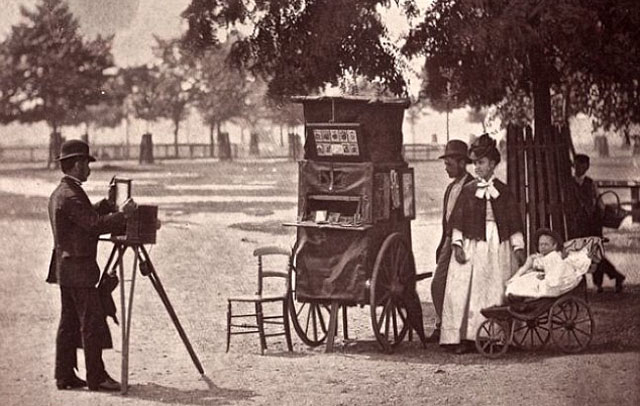
Photography in the late 1800's
The Leica ushered in a new concept of "small camera, large print", which was entirely new. Until then, whatever the size of the camera determined the print (which was made 1:1 of the negative from the camera).
Fast forwarding, Leica became the camera from that moment of conception in 1925, until the 1970's when Japanese producers came up with new ideas for cameras. The SLR camera (Single Lens Reflex that enabled the user to see what the lens saw, via mirrors) was the new thing, and Leica tried to hang in by making "Leica versions" of the cheaper Japanese cameras, such as the Leicaflex.
You can read my article, "Famous Leica Photographers" to get an idea of how popular and important the Leica became to photography after it entered the scene in 1925.

By the 1960's professional photographers used all sorts of camera systems, all of them much less compact than the Leica.
| |
|
|
| |
Why is it called a "camera"..?
The word Camera is today's short name for Camera Obscura (which originally means “a dark room”).
Origin of the word Obscura means "dark" or "covered", and the word Camera means Chambre and was used originally only as a Latin or alien word, actually only for Spanish soldiers' rooms, until popularized in connection with photography in 1727: “Camera Obscura”.
In 1793 the slang term “camera” was used by Sterne Tr. Shandy: “Will make drawings of you in the camera” and by Foster (1878), “The eye is a camera”.

Ibn-al-Haytham mentioned Camera Obscura in his "Book of Optics" in 1021.
The concept of Camera Obscura was described by Iraqi scientist Ibn-al-Haytham in his book, “Book of Optics” (1021) and by Leonardo da Vinci in 1500; popularized and made widely known in 1589 by Baptista Porta when he mentioned the principle in his book “Natural Magic”. Johannes Kepler mentions Camera Obscura in 1604.
Camera = chambre (room), Obscura = dark (or cover). |
|
| |
|
|
1) The Leica-Minolta joint venture for a compact film camera
Starting in 1971 and going onwards to 1982, Leica started a joint venture with Minolta and made a "small Leica M" film camera, the Leica CL. The idea was not the size, but that it would be a great intro camera to the Leica M system as it cost much less to buy.
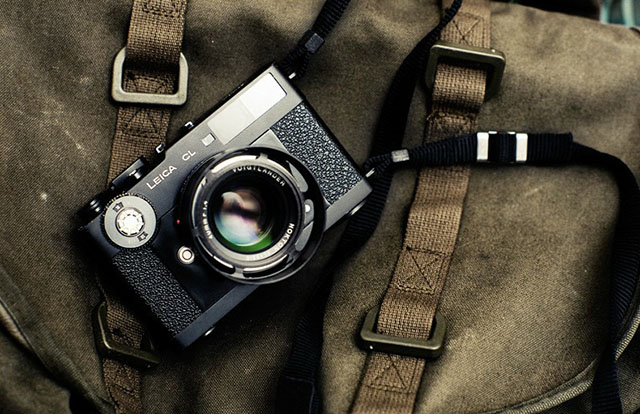
The Leica CL 35mm film camera was made as Leica CL and Minolta CLE, with whom this was shared technology. Also two CL lenses were made together with it, a 40mm and 90mm as economical alternatives to the Leica M lenses (which they shared a bayonet with). CL stands for Compact Leica or Compact-Light-measuring as the internal light meter was also one of the new technologies added in this model.
Much could be said about the Leica CL film camera, but the conclusion is that Minolta learned a lot about optics and mechanical precision from Leica, but for Leica it didn't solve their essential problem: That the majority of photographers in the world turned away from Leica M to the more fancy SLR cameras which offered auto focus, motorized film advancement, long tele lenses and more new features. In one way, it was a healthy shake-up of photography, which brought us for example internal light metering (instead of external hand-held devices) and other new ways of doing things. But it also brought a lot of features that keep being invented and integrated into cameras, which have very little to do with photography.
It is very unusual for a German company with a legacy like the one of Leica to engage in joint ventures or alliances with other companies. They usually see themselves as so unique and perfect, everybody else should be learning from them and not the other way around. As you will see in this article, Leica has been able to rise above this and make alliances with other lens producers (for the Leica L mount), camera producers (Minolta, Panasonic, Fujifilm and Zenith), smartphone producers, as well as taking advice from companies like Apple, Hermes, Porsche and Audi on design and production management.
Even though the Minolta joint venture didn't go that well, Leica was at it again twenty or so years later when they engaged with another large Japanese camera producer:
2) The Leica-Panasonic compact digital cameras
The Leica joint-venture with Japanese Panasonic started officially in 2002 (with an early start in 1995 on the Leica Minilux) and has been a great success for both companies. Leica provide lens designs for Panasonic cameras, which they are paid royalties for, while at the same time, Leica gets Panasonic to produce digital camera editions with the Leica logo and minor adjustments to the design. There is no doubt that Leica camera benefits greatly financially from this joint venture, selling know-how they spent more than 100 years earning.
In essence, the Leica editions of the cameras are for people who appreciate the brand and just feel better having a Leica branded camera than a Panasonic branded camera. For those who want to save money on the other hand, there are many reasons or arguments why the Panasonic will do the job just as well. That choice is entirely a personal one. What can be said to throw a few nuances into the choice:
A) While the price of the Leica and Panasonic versions usually start almost at the same price point (with Panasonic at 85%-90% of the Leica retail price), the Panasonic price as second-hand drops fast and low while the Leica second-hand prices tend to stay much higher (which in essence means that buying a Leica and selling it later cost the same or less in the end than buying the cheaper Panasonic).
B) The Leica version is said to employ much stricter quality control to lens assembly than Panasonic, hence why Leica throws away 90% or so of the lenses while Panasonic uses them all. True or not, the question is if one would be able to notice the difference in a compact camera.
C) In some cases, the firmware in the Leica vs the Panasonic version differs, giving the Leica more natural and less saturated colors.
3) Leica on the smartphones
Leica has been involved in smartphones for quite some years, and this is undoubtedly a "hidden" business that has greatly benefited Leica Camera AG. For a while, lens elements were produced for unnamed smartphone manufacturers, and then, from 2016, their lenses were branded Leica on HUAWEI smartphones, with the P9 being the first model. This collaboration continued with models up to the P50 in 2022. Leica has also created their own Leitz Phone for the Japanese market and continues to make optics for several brands of smartphones, Xiaomi 14 being one of them (where you can actually attach a real Leica M lens to it as well).

The Leica D-Lux 7 was introduced in 2018 with 17MP sensor and a very light-strong zoom lens, the 24-75mm f/1.7-2.8. A black version of this camera was introduced in June 2020. Here my silver Leica D-Lux 7 seen with the Always Wear a Camera calfskin strap in yellow.
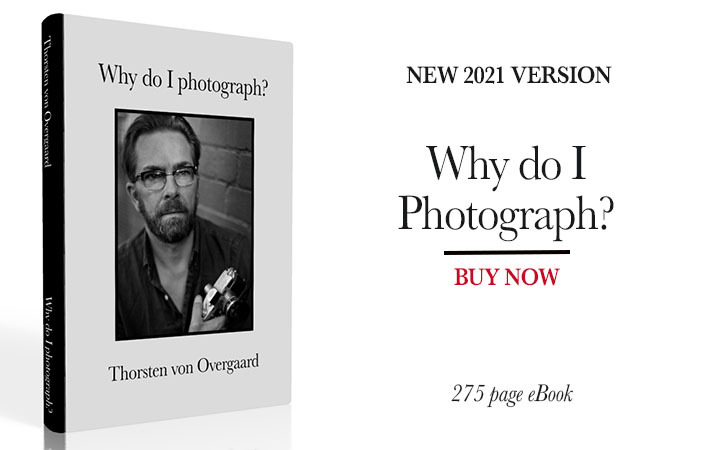
The Leica D-Lux series was introduced first in 2003 and as such it has been the most consistent series of digital compact cameras from Leica. They were also some of the first digital Leica cameras ever, introduced in 2003 where Leica was still making film cameras and sort of believed film would always be there in the future. By going into cooperation with Panasonic, Leica was able to offer the D-Lux cameras, leaning heavily on Panasonic who had already gained the know-how, experience and manufacturing skills to mass-produce electronic cameras.
As is the case with all the Leica cameras made with Panasonic, they don't have the same simplicity as the cameras Leica makes themselves. The cameras generally have too many buttons and too many choices to be made in the camera menu. It's a great irony of photography that the smaller the camera gets, the more complicated they are. It simply comes with the consumer territory that you produce and sell cameras promising new features which "do it automatically for you".
The Japanese culture admires aesthetics and simplicity, as in "The perfect samurai never draws his sword", but when it comes to electronics (and water closets), they get very complicated.
The Leica D-Lux 7 is a great camera if you can tame the overflow of features. By that I mean that you should study the manual while you have the camera next to you. Learn each feature and then decide which you should omit using. With professional cameras like the Leica M it is very easy, because on those the buttons and features are limited to what you need. As photography means "writing with light", there are only the three essential controls to manage light. The rest - on any camera - is just marketing.

Leica D-Lux 7. © Thorsten Overgaard.
On the Leica D-Lux 7 (which is the sister camera is the Panasonic Lumix DC-LX100 II) one will notice that Leica Camera AG and their philosophy about quality images and simplicity of operation starts to play in. Contrary to earlier models of the D-Lux , the D-Lux 7 features the dial on top of the camera which has been made into a classic and simple shutter speed dial, which in essence gives the user the possibility to quickly adjust the exposure of the photograph (in previous models the dial was a selection of "presets" that never made any sense but nonetheless are on most digital cameras these days "to make it easier").
Leica D-Lux 8

Leica D-Lux 8 (2024). Read my review and user report here.
The Leica D-Lux 8 (2024) has the great advantage that is is Leica simplicity in button layout and menu control. It also has a low light zoom lens that starts at f/1.7 for wide angle, and f/2.8 for tele.
Also, the aperture dial is on the front of the lens like in classic cameras; which is another choice the user can control the light with. As such, the Leica D-Lux 8 is in many ways operated like a Leica M or Leica Q.

Leica D-Lux 8 controls. Read my review and user report here.
Finally, the Leica D-Lux 8 zoom lens can now be operated with a zoom ring on the lens (or when in Manual Focusing mode, this ring is the focusing ring). It also has the traditional zoom button that compact cameras generally feature. But a zoom ring on the lens is the traditional and logical way to operate a zoom lens; and now it is back!
So far the features and buttons. Fundamentally the Leica D-Lux 8 features a high quality Leica lens as well as a sensor that produces high-quality images with 13 stop dynamic range (the Leica M has a 14 stop dynamic range). The dynamic range is how well the camera's sensor can capture highlight and shadows at the same time; but more importantly an expression for how well the camera can capture tonality and colors across the spectrum, and with details.
Here is an overview of Leica D-Lux models, including which battery for Leica D-Lux. The Leica D-Lux 7 or Leica D-Lux 8 would be my choice, but in second-hand and less expensive Leica D-Lux models, the Leica D-Lux 6 ($400-$500 second-hand) stands out with an excellent lens:
 |
Leica D-Lux models over the years: |
 |
| Model |
Year |
MP |
Zoom |
F-stop |
Memory |
ISO |
Video |
Weight |
Battery |
 |
| D-Lux 8 |
2024 |
17MP |
24-75mm |
f/1.7–2.8 |
|
200-25600 |
4K 30fps |
397g |
BP-DC 15 |
 |
| D-Lux 7 |
2019 |
17MP |
24-75mm |
f/1.7–2.8 |
|
200-25600 |
4K 30fps |
403g |
BP-DC 15 |
 |
| D-Lux 109 |
2014 |
13MP |
24-75mm |
f/1.7–2.8 |
|
200-25600 |
4K 30fps |
405g |
BP-DC 15 |
 |
| D-Lux 6 |
2012 |
10MP |
24-90mm |
f/1.4–2.3 |
70MB |
80-6400 |
1920 60fps |
298g |
BP-DC 10 |
 |
| D-Lux 5 |
2010 |
10MP |
24-90mm |
f/2.0-3.3 |
|
80-3200 |
1280 60fps |
271g |
BP-DC 10 |
 |
| D-Lux 4 |
2008 |
10MP |
24-60mm |
f/2.0-2.8 |
50MB |
80-3200 |
1280 24fps |
248g |
BP-DC4 |
 |
| D-Lux 3 |
2006 |
10MP |
28-112mm |
f/2.8-4.9 |
|
100-1600 |
848 30fps |
220g |
BP-DC4 |
 |
| D-Lux 2 |
2005 |
8MP |
28-112mm |
f/2.8-4.9 |
|
80-400 |
848 30 fps |
220g |
BP-DC4 |
 |
| D-Lux 1 |
2003 |
3.2MP |
35-105mm |
f/2.8-4.9 |
|
50-400 |
640 30 fps |
180g |
680 mAh |
 |
| © Overgaard |

| |
|
|
|
| |
Leica C-Lux |
 |
|
| |
By Thorsten von Overgaard |
|
| |
|
|
|
The Leica C-Lux was re-launched in June 2018 as simply the C-Lux (sister camera to Panasonic Lumix ZS/TZ200). This time as a very fashionable and very compact camera, yet featuring a 20MP sensor and a 24-360mm f/3.3-6.4 zoom lens. A sort of do-it-all camera for the fashionista, and the price of $1,100 reflects that it is positioned as a fashion accessory (which happens to conceal a real quality camera with a huge zoom lens and 20MP sensor and 4K video). Basically, if you can tame this camera, you won't ever need any other cameras. All you have to do is to decide if you want a Gold or Midnight Blue color.
The Leica C-Lux 1 was originally introduced in 2006, then C-Lux 2 (2007), C-Lux 3 (2008) - then it changed name temporality to Leica V-Lux 20 in 2010, Leica V-Lux 30 in 2011 and a Leica V-Lux 40 in 2012, then to return to the name Leica C-Lux Typ 112 (in Sept 2013 as twin sister to Panasonic DMC-LF1) and then not much happened until the "fashion editions" arrived in 2018.

The Leica C-Lux in Gold, fundamentally a camera that is extremely compact, yet does all that much larger cameras do, while looking great at the same time.
| |
|
|
|
|
| |
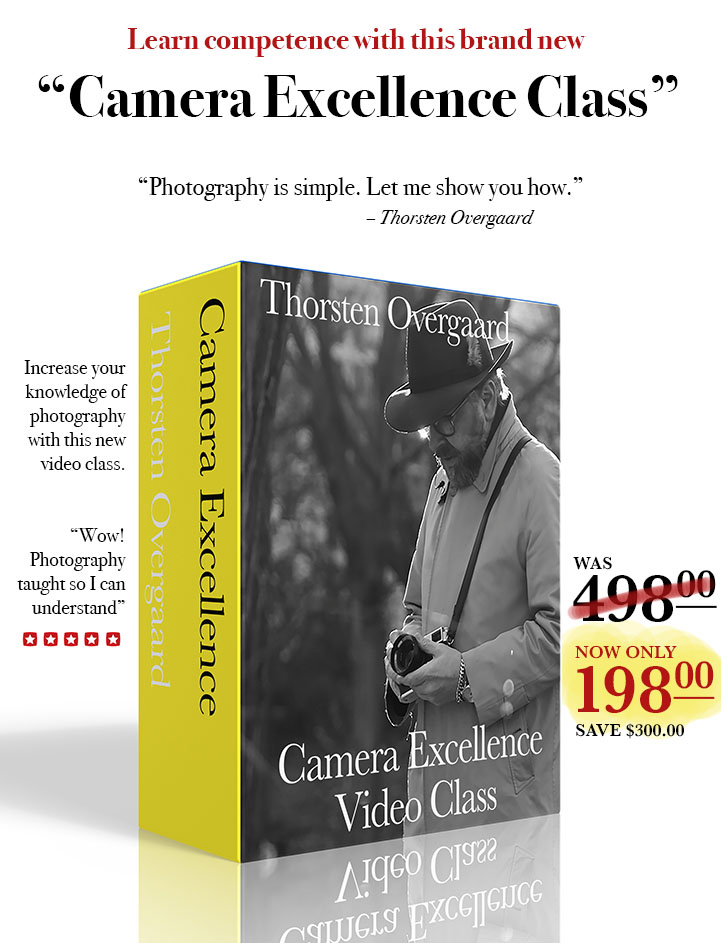 |
|
| |
|
|
|
|
| |
"Photography is simple"
Thorsten Overgaard is one of the best to explain in simple terms how cameras works, and how to get excellent results.
Be competent. Buy and study this easy-to-use video class that explains how to get focus right, what sharpness is, how to get the exposure and the colors right, and more ...
"Easy to apply, photography finally told so everyone can become an expert user"
Normal price $498.00
Explained by Thorsten Overgaard by using Leica Q2, Leica SL2, Leica M11, Leica M10 Monochrom, 35mm film cameras, Leica Digilux 2 and more. |
|
Thorsten Overgaard's
"Camera Excellence Class"
For Computer,
iPad, Apple TV and smartphone.
Normal price $498.00
Only $198.00

Save $300.00
USE CODE: "COXY66" ON CHECKOUT
Brand new. Order now. Instant Delivery.
100% satisfaction or money back.
More info
Item #1847-0323
Released April 2023
|
|
| |
|
|
|
|
| |
|
|
|
| |
Leica V-Lux |
 |
|
| |
By Thorsten von Overgard |
|
| |
|
|
|
Leica also made the Leica V-Lux camera series, which is not a compact camera, but rather a compact SLR camera. It has a built-in lens that can't be changed (and doesn't have to as it covers the whole range), which is the explanation for how it can be so small, compared to a traditional SLR camera. For me, it is too big to "Always Carry a Camera", yet it does have impressive functionalities and quality for the money. 20MP sensor, 4K video and a 25mm to 400mm f/2.8-4.0 zoom lens. Yes, why not?
The models are Leica V-Lux 1 (2006), V-Lux 2 (2010), V-Lux 3 (2011), V-Lux 4 (2012), V-Lux Typ 114 (2014), V-Lux 5 (2018).
(For a while, the Leica C-Lux was renamed to Leica V-Lux 20 in 2010, V-Lux 30 in 2011 and a Leica V-Lux 40 in 2012, before that model returned to the name Leica C-Lux Typ 112 in 2013).

The Leica V-Lux 5 was introduced in 2019 with 25-400mm zoom and 20MP.
2.8) The Leica-made Panasonic camera
| |
 |
| |
The first Leica Digilux (1998). The Leica Digilux Zoom and Leica Digilux 4.3 looks almost exactly the same. |
| |
|
| |
 |
| |
Leica Digilux 1 (2002) by a Leica design team headed by Achim Heine |
| |
|
Previous to the Panasonic joint venture that started in 2002, Leica flirted with Fujifilm in 1998 to make the first Leica Digilux, a 1.5MP digital camera that was Leica's first digital camera and had some innovative design features for that time. The design features followed onto the next two models which looked very similar, the Leica Digilux Zoom (2000) and Leica Digilux 4.3 (2000, photographs are saved as 4.3 megapixel files, the sensor itself is 2.4 megapixels), both made with Fujifilm, and even featured Fujinon designed lenses.
I must admit I spent quite a few moments in front of the local camera store windows, lusting for this very futuristic, yet classical looking, digital camera. I never bought one, but when the next model came, that was the one I finally jumped onto:
In 2002, Leica made a cute retro-designed camera, the Leica Digilux 1 (4MP) that featured their own 33-100mm f/2.0-2.5 zoom lens and cost $1,495.00. This was the fist joint-venture with Panasonic, and the sister camera is the Panasonic Lumix DMC-L5.
It is still a lovable camera as second-hand. Very unique in its design by Achim Heine. By today's standards, very slow zoom and auto focus, but still producing rather nice photos which some might find very classicly film-like. Expect second-hand price to be in the range of $200 - $500.
After these initial attempts to find the Leica soul and a design strategy in the digital age, the Leica Digilux 2 (2004) found its design, which is remarkably close to looking like ... well, the Leica M of course! In retrospect, where else should it go?

Leica Digilux 2 from 2004. A 5MP digital camera that produces excellent JPG files and which sells for $300 - $2000 second-hand as a sought-after vintage digital Leica 16 years later (new price was $1,700). © Thorsten Overgaard.
The Leica Digilux 2 was the first compact camera made with Panasonic where Leica took the driver’s seat and decided how a camera should be made. This unique design also flows over to the Panasonic sister camera, the DMC LC1, which is more of a Leica camera with a Panasonic logo than the previous way around for joint ventures, where it used to be a Panasonic with a Leica logo.
As a spoiler alert, let me just tell that the Leica Digilux 2 with its mere 5MP and an excellent Leica lens turned into such a lovable camera that many bought two and still have a hard time getting the smile off their face. I myself have three of them and have used the Leica Digilux 2 extensively from 2004 to 2009 when the Leica M9 replaced the Leica Digilux 2 for me. I've written a longer, 5-page user-report over several ears of use, with hints and tips on how to use this camera: "Leica Digilux 2 for professional photojournalistic use".

Singer Lene Nystrøm of the Danish pop group Aqua (Barbie Girl). Leica Digilux 2 with flash (using warm gel filter on the flash as described in
the article "Leica Digilux 2 for professional photojournalistic use". © Thorsten Overgaard.
The Leica Digilux 2 became the first "vintage digital camera" in the sense that it's probably the first ever digital camera that didn't end up in the electronics graveyard but stayed in action and in high esteem many years after its release. When introduced it was a $1,700 camera, and today one will find second-hand offerings from $300 - $2,000.
The compactness of the camera is not for pockets, but more for wearing on a shoulder strap across the chest. Just like a Leica M would be used, and then in a messenger bag or camera bag when not worn like that. But a lady’s purse? - no it is not that compact.
A total of 30,000 Leica Digilux 2 were made (serial number 2984401 - 3026100).

Graphic designer Charles Grant with his Leica Digilux 2 in 2009. © Thorsten Overgaard.
| |
|
|
|
| |
Leica Digilux 3 |
 |
|
| |
By Thorsten von Overgaard |
|
| |
|
|
|
| |
 |
| |
Leica Digilux 3 with interchangeable lenses was a blown-up Leica Digilux 2: Larger body, extruded viewfinder, and mirror inside. |
| |
|
As a side paragraph, the Leica Digilux 3 - which is a digital camera but not a compact one - was introduced in 2006 (Panasonic DMC-L1 is the sister camera). Looking like an expanded Leica Digilux 2 version with interchangeable D-mount lenses and a mirror inside (like a traditional SLR camera).
This concept was quickly killed by Leica who didn't make any more models with that "Four Thirds" and D-mount concept, while Panasonic and other brands continued for a while.
2.9) The Leica-made compact cameras
The Leica X1 was released in September 2009, the Leica X2 in 2012, and Leica X Typ 113 was released in September 2014, all with a fixed 23mm f/1.7 lens.
The X series expanded with the Leica X Vario Typ 107 with a zoom lens (28–70 mm f/3.5–6.4) and a Leica X-E Typ 102 was released in with a 24mm f/2.8 lens. The Leica X2 also came in a limited Paul Smith edition.
The Leica X series never did it for me, but I met quite a few Leica X Vario users who really loved their Leica X and Leica X Vario.
Designed in Germany, produced to a large degree in Vietnam and then final assembling and all in Germany, this is a camera that is very traditionally Leica in its design and simplicity of operation. By today's standards and more recent Leica compact digital cameras, it's not equipped with fast autofocus or fast anything.

Leica X2 limited edition Paul Smith.
| |
|
|
|
| |
Leica X-U |
 |
|
| |
By Thorsten von Overgaard |
|
| |
|
|
|
The Leica X-U came out in 2016 as an underwater Leica camera, Leica X-U (Typ 113) (2016) with a 16MP sensor and built-in flash. The idea is a camera you can take anywhere in the rain, on the beach, or even underwater. So many people seem concerned for water in regards to their cameras, so just like the iPhone can go underwater, so can a Leica now.
| |
|
|
|
|
| |
New eBook from Thorsten Overgaard:
"The Portrait Book
– How to Make People Look Beautiful" |
|
| |
|
|
|
|
| |

"Love the book.
Very insightful and very well done"
"You are my favorite author" |
|
Questions answered in this new eBook:
- What’s the secret behind Mona Lisa?
- How do you make anybody look beautiful?
- What is the right timing for portraits?
- What do you say to the people?
- How to photograph your spouse?
- How to edit portraits?
- What is the one right thing in all portraits?
- How to do research for portraits?
- What is the secret to light in portraits?
- Which lens to use for portraits?
- What is the composition rules for portraits?
- How to photograph children?
- Who should I photograph?
- How to do street portraits?
- and more...
Buy Now. Instant Delivery.
Only $298.00
578 pages.
Released April 5, 2020
|
|
| |
#1905-0119 |
|
100% satisfaction or money back. |
|
| |
|
|
|
|
3) The original Leica compact cameras
In recent years - let's say from 2010 and onward – Leica Camera AG seem to have grasped the electronic parts so well that they have become able to invent and design the electronics "the Leica way", which means simplicity with focus on image quality instead of features.
| |
 |
| |
Mechanical assembly at Leica in 1946 |
| |
|
Understand this: Leica Camera AG is a company founded as an optical company in 1849. They were located in the Wetzlar area about an hour drive from Frankfurt, an area known for its metal industry.
The core competence of Leica has been engineering and the ability to shape metals and optics into precision instruments. So, when electronic cameras entered the scene, this was an alien concept that Leica in the beginning simply outsourced, or bought from others.
Only in recent years has Leica built in-house competencies, excellent in "thinking simplicity and high image quality", into their electronics. See my "Leica History" page for more on the fascinating history of Leica.
The first 100% Leica-made compact camera that was entirely designed and produced by Leica Camera AG, was the Leica TL (2014). A complete re-think of the camera concept; how should a camera be made from scratch in our day and age?
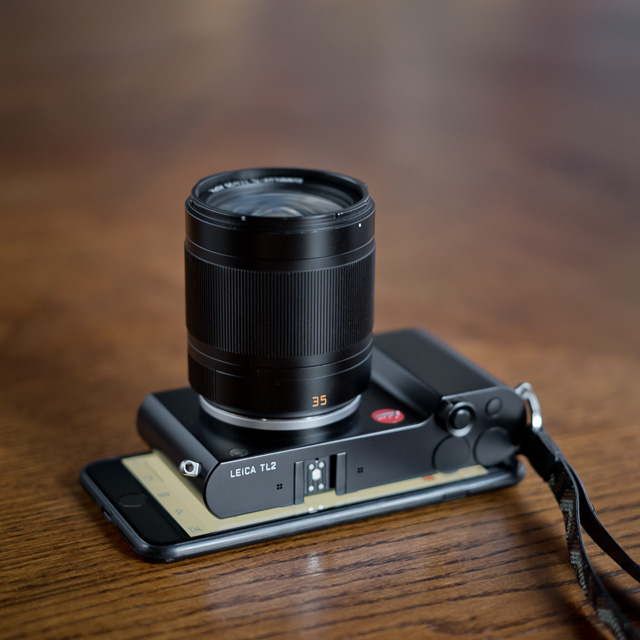
The Leica TL2 (2017) compared with the Apple iPhone 7 Plus. Some years ago, every time you showed a Leica to someone at the Apple campus, the first thing they would do was to say "Hmm" and put an iPhone on the back of it to see how you could combine the two. Here the Leica TL2 with the 35mm Summilux-L f/1.4 lens. © Thorsten Overgaard.
The result was the Leica TL (the first models were simply called Leica T) which has a touch screen and a couple of buttons on the camera. Also, the entire camera was drilled from one piece of aluminum (as the much hyped new Apple MacBook at that time).
A camera concept utilizing peoples' use of smartphones to take photos (using the screen rather than a viewfinder), the touch interface, and launched in a slick design with new fancy rubber camera straps and more modern ideas. That is the Leica TL concept.
While any "old-timer" who grew up with traditional cameras of course uses the viewfinder to frame and take a photograph, people nowadays use a screen to frame and take a photo or a video. Hence the Leica TL concept makes complete sense on how to have a smartphone user upgrade to a 24MP camera where you can change between a range of high-quality lenses.

A woman in London photographing with her iPad. © Thorsten Overgaard.
Under the hood of the Leica TL was a new series of L-mount lenses that - we learned later - were designed to be future proof in more than one way:
A) The lenses all implemented twice as high resolution, meaning that they were designed optically so they are prepared for 100MP or 200MP sensors. As we have taken 15 years to get to 50MP sensors in the most well-equipped consumer cameras (and 20MP in most), it will take another 15-30 years to get to 200MP.
B) The way the lenses were designed took into consideration how the production could be effectively done in the Leica factory in Portugal. Many elements of the lenses are universal for all lens models, making production of spare parts and the assembling itself very effective. This was a move that Leica had help from Porsche to set up.
C) The Leica TL lenses were forward-compatible with the yet unannounced Leica SL, which is the full-frame version of the classic SLR camera. But in this sense it was a rethink of how a professional camera should be (drilled from one piece of aluminum, no mirrors as the viewfinder shows what the electronic sensor sees, very simple controls, and deploying a new series of L lenses that fits the Leica TL and vice versa).
Another detail is that one can fit any Leica lens, as well as any Nikon, Canon or other brand lens onto the Leica TL via adapter.
While the first Leica T models were not that amazing (as to speed of auto focus), but yet a success in sales figures, the Leica TL2 that came out in 2017 (with 24MP sensor and super-fast auto-focus) was the first really competent Leica compact camera of this model. I have used the Leica TL2 quite a bit and always keep it handy.
As part of an overall strategy to only make full-frame cameras in the future, the Leica TL3 quietly has just not been announced, and probably never will be. What the Leica TL concept, along with the Leica S concept (for medium format cameras), did produce was the Leica SL cameras; and likely an SL-type camera could be the future. What is an SL-type compact camera? Well, it is one that uses the same lens bayonet as the Leica TL (which it shares with the Leica SL), but with a full-frame sensor.
Not hard to imagine, probably not impossible to make, but how will it look, and when will it be launced?
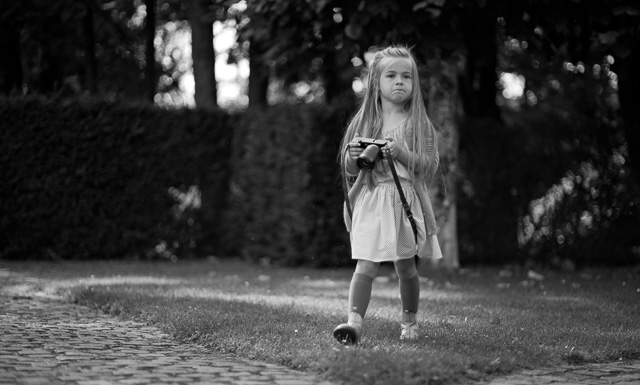
Out and about with the Leica TL2.
© Thorsten Overgaard.
The biggest success - and the most soulful Leica compact camera - is the Leica Q which was introduced in 2015 with a full-frame 24MP sensor and a built-in high quality electronic viewfinder at $4,995.00 and refined further with the Leica Q2 (2019) featuring a 52MP sensor and refined controls to make the camera even simpler and more intuitive, and once again witht he Leica Q3 in May 2023 with a 60MP sensor. And then in 2023, Leica introduced the Leica Q3 43 APO, fundamentally the same camera as the Leica Q3, but with a 43mm APO f/2.0 lens, more suitable for portarits and street photography.
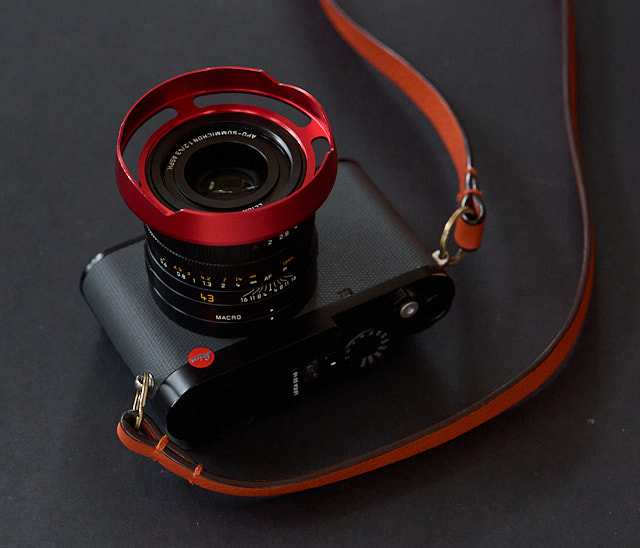
The Leica Q3 43 APO the Leica Q Ventilated Shade designed Thorsten Overgaard for "Always Wear A Camera". Available in black paint, matte black paint, RED, Safari Green and Silver.
The overwhelming success of the Leica Q cameras is because they are founded on the Leica tradition for mechanical and optical perfection, with competent electronics applied: Super-fast auto focus, high image quality and no nonsense controls of the camera menu. Add to that a to-die-for design that has it all without having anything, there you are.
In 2021, also the Leica Q2 Monochrom was released, a black-and-white only camera for the minimalist. For the person wondering which camera to get, APS or full-frame sensor, which lenses to get, and all that jazz, it doesn't get much simpler than this: Full frame, one lens by the worlds best lens designers, and no worries about colors, super resolution, and easy to always carry in a strap across the chest.
Read my long review and user report of the Leica Q here, "To be, or not to be, that is the Q", as well as my Leica Q2 user report and my Leica Q3 user report.

The Leica Q (2015) with Leica handgrip and "Always Wear a Camera" leather strap and "Always Wear a Camera" ventilated shade. © Thorsten Overgaard.
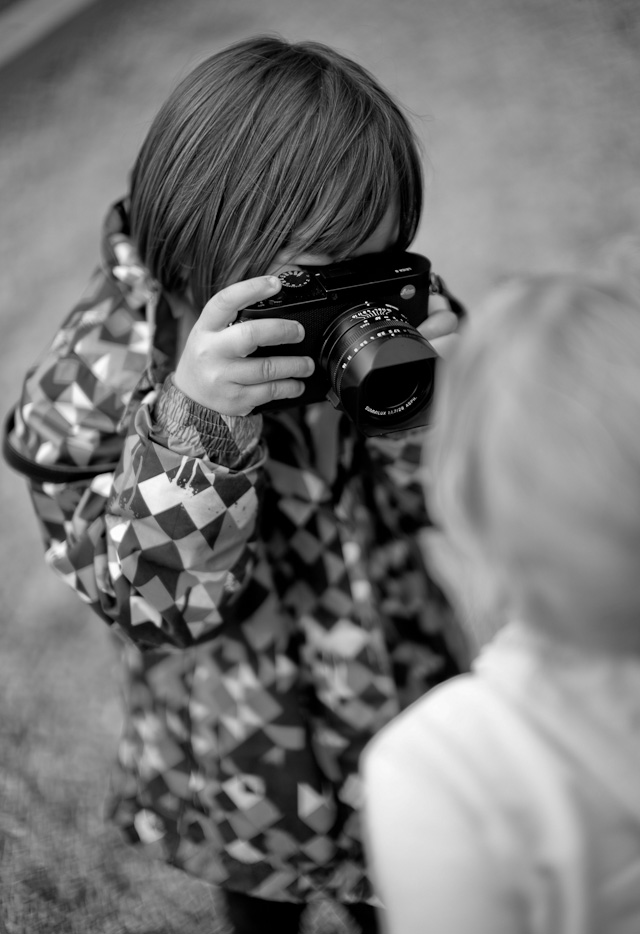
The best-seller Leica Q (2015) or Leica Q2
(2019) is the perfect gateway-drug to get the kids, spouse and friends into photography ... and soon after they want a Leica M camera.
| |
|
|
|
|
| |
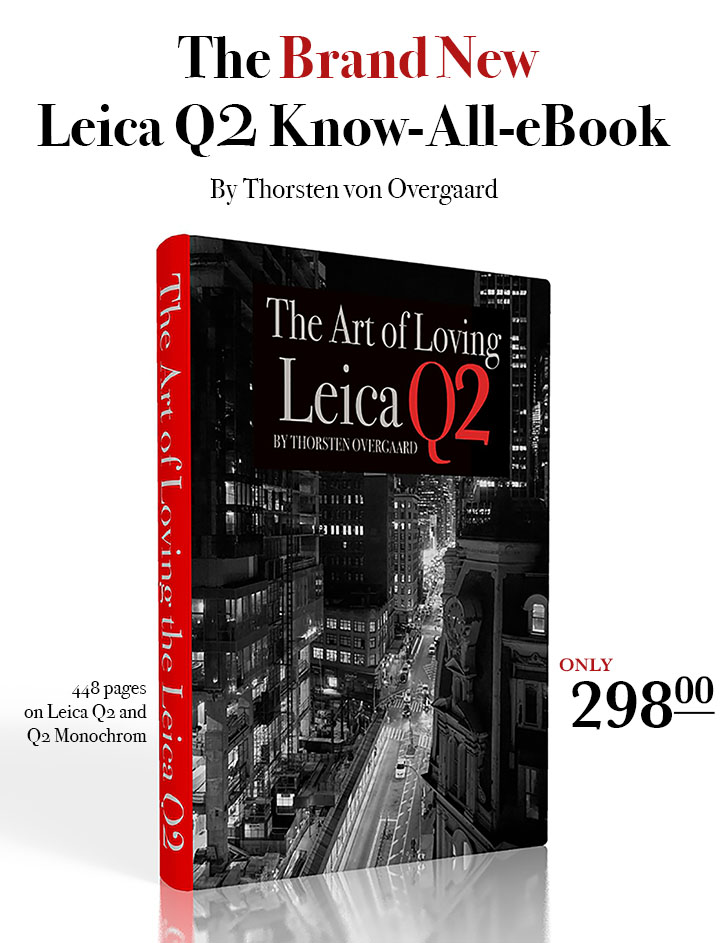 |
|
| |
|
|
|
|
| |
Full Leica Q2 Pack
14 video classes with work book
+ 448 page eBook,
+ Styles for Capture One for Leica Q2
+ Lightroom Presets. for Leica Q2
Normal price $821.00
Normal price $821.00
Save 45%
Only $448.00
USE CODE: "ILOVEQ2"

Buy now. Instant delivery via email
100% satisfaction or money back.
Item #1914-0521 |
|
Leica Q2 Know-All-eBook
448 pages illustrated for Computer,
Kindle,
iPad or smartphone.
Only $298.00

Buy now. Instant delivery via email
100% satisfaction or money back.
Item #1914-0820 |
|
| |
|
|
|
|
| |
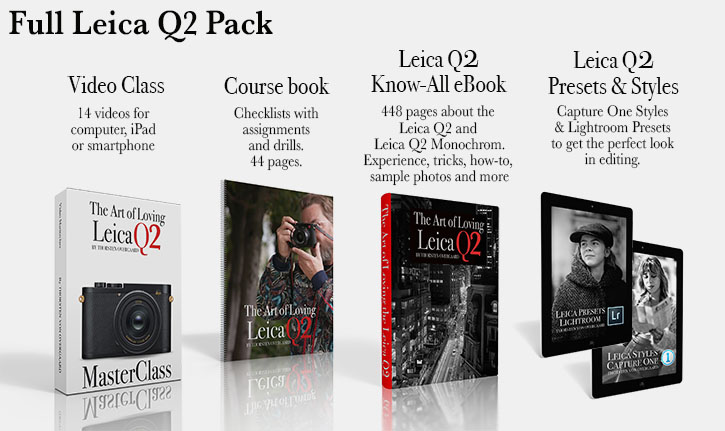 |
|
| |
|
|
|
|
The Leica CL came out in early 2018 as another compact camera that takes the same Leica L lenses as the Leica TL2 and Leica SL cameras.
It's been a request from customers every time Leica made a compact camera that one could change the lenses. However, compact usually means that the lens is a fixed lens - for reasons of price and compactness. But with the L lens concept it became possible to make the Leica CL, a fairly economical and very compact camera - and at the same time makes it possible to change lenses.

My digital Leica CL (2018) with 18mm Elmarit-TL f/2.8 with my "Always Wear a Camera" Ventilated Shade. The Leica CL wash phased out by Leica in 2023 as part of an overall strategy only to make full-frame cameras int he future.© Thorsten von Overgaard.
As with the Leica TL2 and Leica SL, the Leica CL obviously also can take Nikon, Canon and many other branded lenses via adapters (the Leica M lenses, let’s not forget). As the camera has a built-in EVF (Electronic ViewFinder), there is no focusing system that has to match the camera mechanically: When it is in focus on the screen, it's in focus.
The EVF is one of the main points of the Leica CL. For a long time, it was not possible to get a high-quality EVF in a compact size so it could be integrated into a compact camera. But there you go, in the Leica CL it works!
With the Leica CL, the ends meet: Compact EVF, compact lens bayonet system that allows one to couple up to all the Leica L lenses, and an overall compact size with high ISO and high sensor resolution.
A Paul Smith limited edition of the Leica CL came out in November 2019 as well.
The new Leica full-frame compact camera?
2024 is the year when we will see a turn in events for Leica compact cameras. Leica already announced in 2023 that they would not make APS-C sized sensor cameras anymore (and thus the beloved Leica CL and Leica TL2 ceased to be developed further), and the future would be full-frame cameras.
While they did not mention compact cameras, the development of new models has been underway. The Leica SL3, Leica M11, and the compact Leica Q3 are the full-frame cameras, and a medium format with an even larger sensor is expected in 2025 or so.
It is likely that Leica will follow with their own full-frame compact models, meaning "100% Leica models" with full-frame sensors. But in the compact class. So, obviously, more compact cameras and interchangeable lenses are high on the wish list from Leica users. And soon they will come...
There is the obvious candidate for a inexpensive future compact Leica full-frame with L-mount, the Panasonic Lumix S9 (24MP camera released May 2024) with full-frame sensor and L mount.
And, despite the "no more APS-C sensors", I would expect that Leica keep making "not their own" compact cameras with Panasonic - those could be fixed lenses or whatever, with APS-C or full-frame.

Leica CL photo using an adapter so as to fit the Leica 50mm Noctilux-M ASPH f/0.95 onto the camera. My balcony in Los Angeles. © Thorsten von Overgaard.
| |
|
|
|
| |
Leica Sofort and Leica Sofort II |
|
|
| |
By Thorsten von Overgaard |
|
| |
More resources: |
|
|
| |
Leica Sofort article by Thorsten Overgaard (2016) |
|
|
| |
|
|
|
Leica made a Polaroid or instant camera in 2016 ($298.00), and another Leica Sofort II model in 2023 ($398.00) that was also hybrid in the sense it could be a digital camera.
Mostly as a gadget many peopole woiuld buy, just beacuse it was available and fun.

Leica Sofort was made in mint, white or orange. Price $298.00 November 2016.

The Leica Sofort II (2024) is borh a digital, an instant camera and a printer ($398.00).
Which compact Leica to get?
As you can imagine, that is not an easy question. One advice I always give and which never fails, is to treat the choice of cameras the same way as you choose a cat: You go to the camera store (or imagine virtually) and line up the cameras you think you should decide between: The one that appeals the most to you, that's the one.
If you ever visited a mother of eight newborn cats, there's always one of the small babies that appeals to you and it’s "the one". The same with dogs. And now with cameras and lenses.
You have to choose with the heart. You can choose a camera by the number of megapixels or features, value for money spent, resale value and all that, and that might be a sensible way to do it. But will that make you happy?
For myself, I can get a feeling that the Leica C-Lux is a great camera that would be really fun to use, and that would be my only reason to get one. It doesn't make much sense technically because there are so many reasons to get a real big camera that does the same (long zoom), but there's something about the C-Lux.
That "something about this camera" is what will make you take the camera out and use it. Great specifications and five-star reviews will not.
So that is how you choose a camera easily: With the heart.

Choose camera and lens with the heart. © Thorsten Overgaard.
| |
|
|
|
|
| |
 |
|
| |
|
|
|
|
| |
"Photography is simple"
Thorsten Overgaard is one of the best to explain in simple terms how cameras works, and how to get excellent results.
Be competent. Buy and study this easy-to-use video class that explains how to get focus right, what sharpness is, how to get the exposure and the colors right, and more ...
"Easy to apply, photography finally told so everyone can become an expert user"
Normal price $498.00
The principles of photography and any camera explained by Thorsten Overgaard using Leica Q2, Leica SL2, Leica M11, Leica M10 Monochrom, 35mm film cameras, Leica Digilux 2 and more. |
|
Thorsten Overgaard's
"Camera Excellence Class"
For Computer,
iPad, Apple TV and smartphone.
Normal price $498.00
Only $198.00

Save $300.00
USE CODE: "COXY66" ON CHECKOUT
Brand new. Order now. Instant Delivery.
100% satisfaction or money back.
More info
Item #1847-0323
Released April 2023
|
|
| |
|
|
|
|
Extra cameras
For some, a compact Leica is not a choice of the only camera, but rather an extra camera for backup or for some other reasons we give ourselves.
For me, I find that on one hand I try to simplify my equipment by only having the things I really use. When used a lot, I always keep them because we have a sort of relationship that stretches back. Other cameras or lenses I get and they never become a great friend. Often I learn something by taking on a new camera or new lens, even if I don't keep it. Sometimes the lesson I learn is why the one I use a lot is so great. For example, the Leica M that I use a lot is sturdy and very simple, and you can kind of forget that other cameras are not simple. So when I occasionally get another brand camera, I am reminded how lucky I am to have a simple camera.
I do have Leica Q, Leica TL2, Leica D-Lux 7, Leica C-Lux and Leica Digilux 2 and Leica Digilux 1 cameras, and I'll use them occasionally. My main camera is the Leica M10P which for my travel and professional photography is to be considered a "very compact professional camera". Frankly, if you spend too much time with me and my website, you will get one too.
Family cameras
Feeding the interest from a spouse, a child or teenager, or even a friend, by supplying them with a camera to use is also a thing I like. In that case it is your obligation to figure out which one they will love the most. Which camera would really get them enthusiastic and taking photographs - and get them yo succeed in making good photographs?
I've met many families where the dad and daughter love photography and can share that interest at home and on travels, or a dad and his three sons, and of course the married couple. To have photography as a shared interest within the family is worth working on. It can change the way you see the world and how you travel.
In a perfect world we should all have a closet full of equipment to make any type of photograph, but in reality most people will get overwhelmed by this new concept of "a camera" and all the learning that comes with it.

Family that photographs together. Mr and Ms Thacker out on a walkabout with me Saturday morning. © Thorsten Overgaard.
The aim is always to have a camera that becomes a natural extension of your vision and your ideas, so that within a few days or weeks, you can be able to use the camera without really thinking about it. You see a picture, and you take it. Much like you write with a pencil on a piece of paper. It's the idea in your mind you see on the paper, not the pencil you use to write and draw it.
A perfect camera for anybody is one that they can grasp themselves, by using it. The Leica Q has turned out to be the perfect entry camera that - except for the price - makes people love to take photographs.

Here I am in 2015 with the 6x6 tilt-shift camera I built 34 years earlier as a kid trying to understand photography. I started out with three compact point-and-shoot film cameras, then went onto the compact SLR camera of the times, the Nikon EM. After a lot of Nikon cameras, I stumbled over the Leica Minilux compact film camera, and from there on it was Leica.
It doesn't make any sense, but ...
The smaller a camera becomes, the more complicated it gets. Small cameras tend to have buttons to do everything, and a camera menu with an overwhelming choice of possibilities.
This doesn't make much sense if you envision a 76-year old woman buying a new camera. When would she ever get the time and the interest to figure all this out? Nevertheless, this is how "consumer cameras" or "compact cameras" are thought out, it seems. No camera producer wants to be left behind when it comes to offering the consumer more bang for the buck.
In that race, the art of seeing and photographing what one sees, gets easily lost.

Leica M10. © Thorsten Overgaaard.
We also live in a consumer and marketing society. New models must come out so the consumers will buy the new and get rid of the old. Often it doesn't make sense, but what are you going to do? The Leica D-Lux 6 (2012) is an excellent camera with a very light-strong lens, and one could possibly easily skip the two later models (2016 and 2019) and live happily. But then again, we both know the cravings to get the newer one, the latest model.
Even though the Leica cameras are known for simplicity and for focusing on the essential, their compact cameras often suffer from the same complication of a relatively simple task: Taking a photograph in focus that is correctly exposed.
The Leica TL is a successful attempt to make a professional performing camera that is as simple as (or simpler, actually than) a smartphone camera. And again, the Leica Q is a very simple and intuitive camera as well.
The Leica cameras made with Panasonic (D-Lux and C-Lux) suffer from too many buttons and to extensive camera menus with too many words nobody knows the meaning of. It doesn't render them useless, it just means that you as the user (or your spouse, friend or child), must learn which features are essential and then realize that all the other features are useless and can be left untouched. A complicated camera - any complicated camera - can be made simple that way.
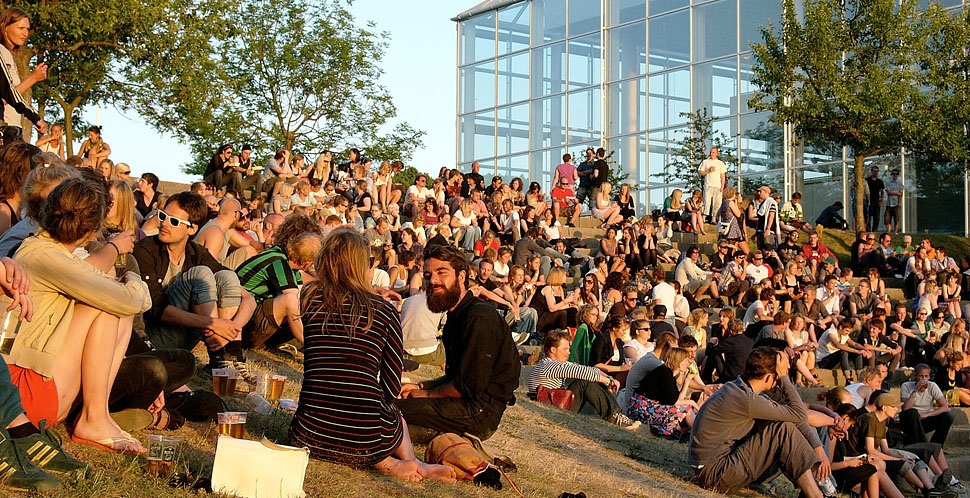
Leica Digilux 2. © Thorsten Overgaard.
Marketing is everything
In an analogy, I have a house in Florida, and as is very common, there were termites in the wood floors. I called a company to inspect it and get a suggestion on the best possible route. They present a piece of paper with three choices which the sales person/inspector goes over. Option 1 is $1,700, option 2 is $2,200 and option 3 is $2,500, and they all come with a subscription thereafter in the range of $400 a year to $300 every quarter that guarantees different levels of security so the termites don't come back. It's a package and insurance policy, and there are three possibilities to choose from.
As I look at this, I wonder, "What about the termites?"
Visiting an American bank is the same experience. There is a chart of different account types and credit card types one can choose from, and they all have more advantages and security the more you pay. You choose this account and you can get two of the others for free, and it comes with a card that gives advantages in the airport as well as insurance (they all automatically have insurance, by the way).
You look at this, and you wonder, "What about my money?"
And of course, often when you look at cameras, you are faced with similar options: Features, prices, number of megapixels, resale value and built quality.
In the analogy of the termites, what is omitted is the obvious question and the reason for talking to an expert to begin with: What about the termites? How do I get rid of them and make sure I don't get them again? Why do I choose from three solution to a problem that there should be just one correct solution to? The answer is that it is not problem-solving, it is marketing.

The Columbia Restaurant Sand Key in Clearwater, Florida. Leica D-Lux 7. © Thorsten Overgaard.
And of course, in choosing any camera, the initial interest is to make photographs. And that is what you must stay focused on: Which camera will make it fun and easy for me to make photographs?
Your most important talent
Your most important talent in photography is that initial sparkle you feel that you want to take photographs, likely to preserve and make things beautiful. That is the sparkle and engine that fuels it all. The camera is a tool.
So, which camera? That is a question you, and only you can answer, and as unbelievable and unsophisticated and scientifically unfounded as it may sound, it simply sits in your heart. You look at them, and you know.
Sometimes it's just the color or the design, but then so be it. That's your camera.
Somebody else who is wiser and has read more reviews and knows more about photography may say otherwise, but then they can go buy that (damn) camera they think is so amazing. You are getting the red one, or the one with the silver button, because that's who you are.

Leica M240. © Thosten Overgaard.
The most important feature of any camera
The most important feature in any camera, is portability. This speaks for compact cameras and smartphones, because those you can have with you. You choose an advanced camera that can do really fantastic photographs of the moon, the insects and all, you likely need a backpack to carry it. Chances are that those marvelous photos of the moon and insects will never happen. You see them all the time, but the camera is not with you.
It's a fundamental question in choosing any camera, "How and when will I use it?", which will rule out a lot of large heavy cameras, and particularly a lot of large zoom lenses.
My mantra is "Always Wear a Camera" which means that you should ideally always have a camera across the chest, ready to use, while the camera is a not distraction or a burden. You see a photo, you take it. There are a lot of things that need to be removed for you to do that elegantly: Complicated settings, weight and size. If the camera looks great and you love it, that helps. If the camera feels like a good friend and easy to use, that works.

The Leica M9 on the table. Taken with Leica D-Lux 7. Edited in Capture One Pro with Hollywood Presets. © Thorsten Overgaard.
What do you like to take photographs of?
Do you want to walk around New York and take photos of graffitti art, do you like to walk about Istanbul and take photos of doors, do you want to take photos of your kids' riding horses, do you want to take quick photos of people in the streets and in cafes..? If you look at realistically, at when and where you would use the camera, you can find the one that suits you - as opposed to getting taken by the promotions for a large digital camea with gigantic zooms you can photograph wildlife with. If you never do wildlife, why would you get a camera that is perfect for that then?
Maybe you need a camera that hangs across your ches and is "Always Wear a Camera" so it inspires you to observe, decide and take photos. Maybe you need a compact camera in the bag that you can take out to do group photos, or whenever there is a specific subject you want to record. Or you do want to hike for two days to get to an amazign view to record in highest possible resolution and quality.
Sometimes the answer is more than one camera for different things. Not one camera that can do it all.

The Leica M9 in the hands of Layla. Leica D-Lux 7. © Thorsten Overgaard.

The difference between
Leica and Panasonic Lumix compact cameras
Panasonic Corporation (From 1935 to 2008 the company name was Matsushita Electric Industrial Co Ltd) was one of the last Japanese companies to start making cameras as they specialized in radio and TV products before this. They decided to start making 35mm cameras in 1991 but had no experience, which is why they teamed up with Minolta who were struggling financially. The two companies agreed to help each other, Matsushita with a loan to Minolta, who in return would supply technology knowledge.
Matsushita (Panasonic) was only feeling the water, so they decided not to buy glass and machinery to make the cameras but instead use Minolta’s mechanisms, electronics and lenses in the Matsushita 35mm cameras. Later that year came a 3-way venture with Matsushita/Minolta/Leica: Leica-branded cameras made in Japan using the German glass, plastic moldings by Matsushita and Minolta mechanisms and electronics.
The later 3rd and 4th generation Leica-branded Japanese-made compact cameras were made by Kyocera Corporation but designed by Minolta, Matsushita and Leica, all with German designed/made Leica glass.
From 1995 Matsushita started making their own cameras with Leica lenses (made in Germany but assembled in Japan).
From 2006 Leica lenses were made in Japan to Leica specifications by Panasonic with 2 main differences, lenses made for the Leica branded cameras are German made, imported machines, using Leica lens coatings, whereas Leica lenses made for Panasonic Lumix branded cameras are made using Panasonic’s mass production machines to Leica specifications, and use Panasonic's own Nano lens coatings.

Saint Hill Manor. Panasonic DMC-LC1 (sister camera of Leica Digilux 2). © Thorsten Overgaard.
Panasonic produces a wide range of Lumix cameras (30-40 models), about half or more use Leica lenses, while the rest uses Lumix lenses (for example Panasonic Lumix DC-G100). One of the reasons are that it takes about 40 minutes to grind and test each element of a lens to Leica specifications. The Lumix lenses are made on faster machines, with much less quality control.
While all produced in Japan, the Leica compact cameras have a distinctly Leica design overall. These are often made of more exotic metals (like titanium or aluminum) than their Panasonic sister models, and are sent to Germany to be inspected by hand and then wired to a computer to have the firmware added so each image gives somewhat the "Leica look" (European skin tones and other color adjustments; and less sharpening). The Leica red dot is added when the quality control has finished, and then the cameras are boxed in Germany with warranty, and free Adobe software.
To be continued ...
I hope you enjoyed today's overview of Leica compact cameras and their history. Look for more specific articles on each camera model, as well as my history of other Leica camera models.
As always, fee free to email me for questions, suggestions, comments and ideas. Until next time, "Always Wear a Camera" and go outside!

| |
|
|
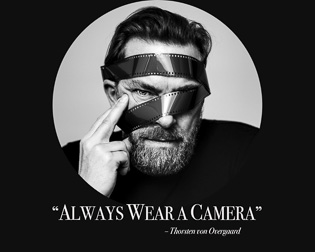 |
|
I like simple things
I make things for myself the way I think they should be, and I use them for my travel to more than twentyfive countries a year. Once I am happy with the way stuff works, I make it available for you to buy.
SHOP THE COLLECTION:
|
 |
|
 |
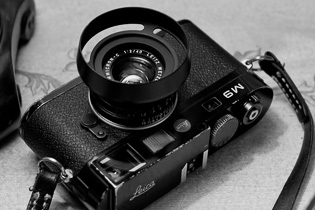 |
|
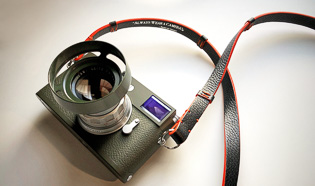 |
Ventilated Shades for most Leica lenses
Classic look to the lenses, sturdy protection against bumps and scratches ... and yes, they shade for the light as well.
|
|
Camera Straps for Leica M and Leica Q
"Simply a leather strap" – My handmade soft calfskin camera strap is the ultimate sophisication in simpliciy and luxury. |
 |
|
 |
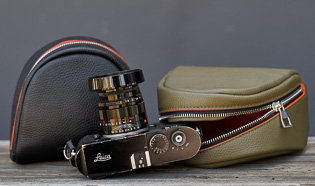 |
|
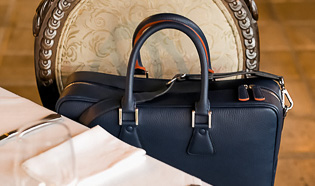 |
Camera Pouches for Leica M and Leica Q
The soft calfskin pouch you don't need ... but you just can't resist! For camera with lens, or to keep track of loose parts. |
|
"The Von" Camera Bag Carry-On Travel
Made to travel in style. Handmade by the best artisans in Milano, Venice and Verona to bring the owner a liftetime of happiness. |
 |
|
 |
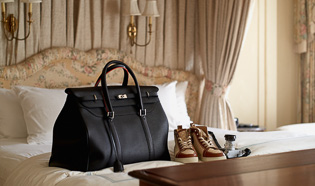 |
|
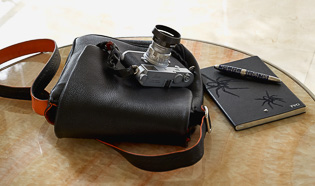 |
24h Travel Bag with lots of Carry-On space
I decided to make a bag with all the space I could ever need to bring onto an airplane.
|
|
The Von Mini Messenger
The Ideal Walkabout Photographers Bag . Tested for three years all over the world by me. |
 |
|
 |
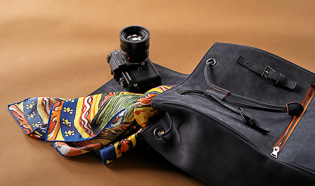 |
|
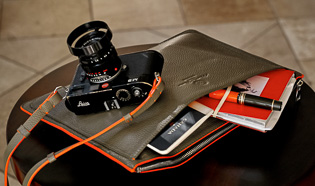 |
Camera Backpack
I've made a series of backpacks becuase they are practical for many things. |
|
Document Carry-On for iPad or Computer
Put a mess of everything in this and you look stylish and organized. |
 |
|
 |
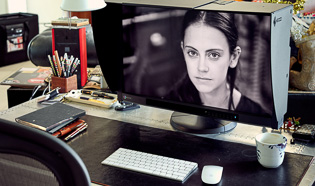 |
|
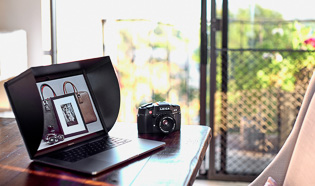 |
Desk Blotters and Larger-Than-Life Mousepad
Nothing beats the feelling of soft calfskin leather on your desk ... but this one takes away reflections, damps the keyboards and makes you happy! |
|
Computer shade for MacBook Pro 15"
Better tonality, accurate colors and concentration for the eyes with my travel shade that snaps onto the MacBook with magnets and folds for travel. |
 |
|
 |
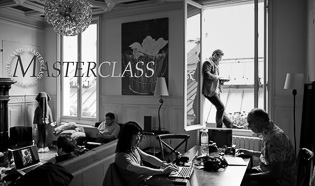 |
|
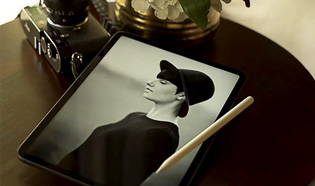 |
Workshops & Masterclasses
With Thorsten von Overgaard for Leica enthusiasts and digital photographers in more than 25 countries a year. Pick your favorite city and meet Thorsten Overgaard. |
|
Photography Extension Courses
Start an extension course with Thorsten Overgaard, work at your own pace and take the time you want. At your own pace, and home |
 |
|
 |
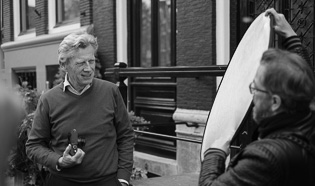 |
|
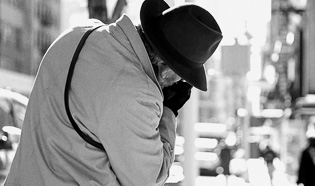 |
One-on-one Training anywhere in the world
Train with Thorsten Overgaard personally, tailored for you and private, any place in the world, or online.
|
|
Video Classes: Learn from Thorsten Overgaard
Watch to learn about your camera, how to use light, how to do street photography, or simply to stay inspired. |
 |
|
 |
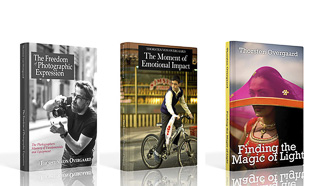 |
|
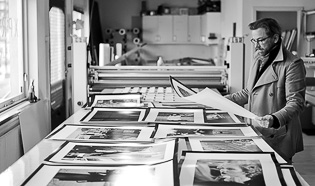 |
eBooks on Photography
The foremost Leica expert and multi award-winning photographer Thorsten Overgard write books that teach and inspire. |
|
Signed Prints by Thosten von Overgaard
Select photgoraphs from the archive of Thorsten von Overgaard, signed, sealed and delivered for your collection.
|
 |
|
 |
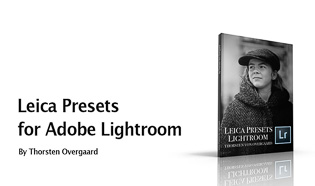 |
|
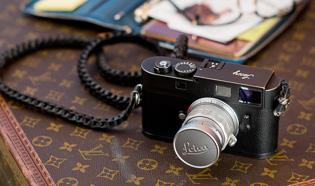 |
Adobe Lightroom Presets for Leica
As a Leica and Lightroom user you will love the simplicity and original look of the Presets Thorsten made for his Leica files. |
|
Used Leica Cameras
Ken Hansen New York Inc updated stock list of second-hand Leica lenses. |
| |
|
|
| |
|
|
|
![]()
